15 Ways To Add More Flavor To Boiled Potatoes
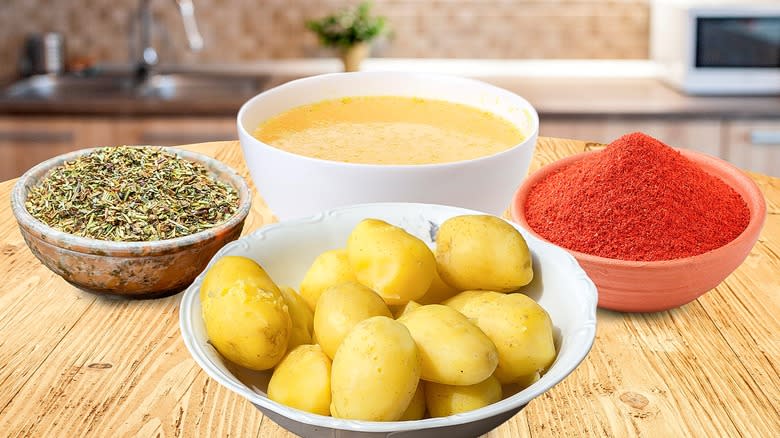
Give your boiled potato some pizzazz. There are plenty of cooking methods, with mashed and fried potatoes being among the most popular. However, boiled potatoes deserve some recognition. Boiling potatoes is one of the easiest ways to cook them since they don't require much work. Potatoes are a cooking staple for a reason. They're affordable, versatile, and diverse. You can often purchase a 5-pound bag of potatoes for under five dollars, and you can make potatoes for an array of dishes, from breakfast to dinner to dessert.
You could follow one potato recipe every day of the year and never run out of ideas for years to come. You can get creative on how you want it to taste when it comes to boiled potatoes. It comes as a blank canvas waiting for you to paint and jazz it up with flavor. Whether you want a pickle-inspired boiled potato or you want a slightly crunchy, salt-crusted potato, look no further for innovative ways to flavor up your boiled potatoes. They will never be the same.
Read more: 21 Delicious Ways To Use Up Leftover Rice
Start With Cold Water

A nicely boiled potato makes for a yummy potato. Keep things uniform by allowing the potatoes to boil in the water, rather than boiling the water beforehand. While it may be easier to just chuck the potatoes in hot water, there's a little bit of science to boiling potatoes efficiently. When it comes to boiling potatoes correctly, you should place your potatoes in cold water -- otherwise, the outside of the potatoes cook quicker than the inside. This will give you potatoes that are cooked unevenly with a mushy outside and firm inside.
Luckily, boiled potatoes don't require a lot of babysitting. Place your potatoes in the cold water, turn on your stove, and keep an eye on it as it boils. If you're not sure how to tell when it's done, stick a fork in it to check. The potatoes should be tender and soft but shouldn't disintegrate to the touch. Turn off the stove and strain your potatoes from the water, so they don't continue cooking in the hot water. Now your boiled potatoes are cooked and ready to go.
Don't Skimp On The Salt

Salt is used to flavor many dishes. It's a great cooking essential to always have on hand to flavor things up. Add a liberal amount of salt to your water to give your potatoes a salt crust. The water becomes so salty that it crystalizes onto the potato. This isn't a salty-like-the-sea type of saltiness that you'll hear about to season water; You'll need to essentially cover the potatoes in salt, add water to cover the salt, and then bring it all to a boil so the salt dissolves.
It's a lot of salt but it's a simple and effective method. There are different types of salt such as pink Himalayan salt and Celtic salt, but you can use any for this method. Once cooked, remove them from the heat and allow them to sit in the water to cool briefly. Remove from the water and your potatoes should have a crisp skin.
Pick The Right Potatoes To Boil
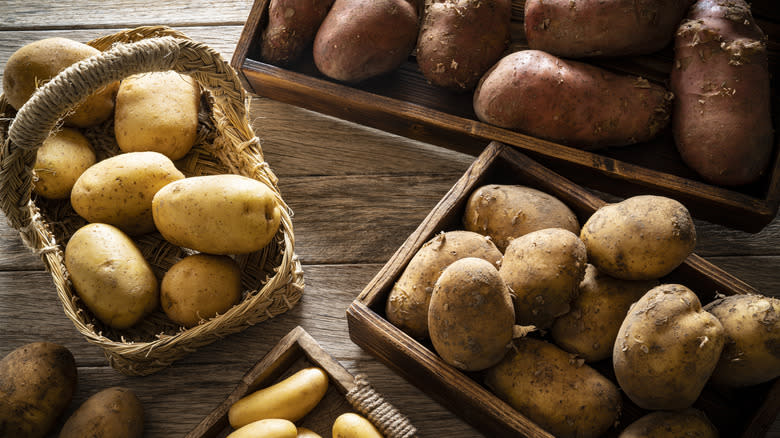
Not all potatoes are created equal. They come in different varieties, textures, and sizes, which ultimately play an important role in the end product. There's a difference between potatoes used for baking and boiling, and it all comes down to the starch content. Each variety will differ, but boiling potatoes will contain lower amounts of amylose starch and higher amounts of amylopectin starch. Amylopectin starch allows the potato to keep its structure whereas amylose starch swells and expands to make the potato airy.
Consider red-skinned potatoes, blue Peruvian potatoes, Yukon gold, or fingerling for your next boiled potato recipe, so they can hold their shape. However, this does depend on what you do with your boiled potatoes. If you're going to mash them up anyway, you can use just about any type of potato. Stick to a boiling potato if you're keeping your potato whole or want a boiled potato that holds its shape without getting overly mushy.
Boil In Pickle Juice

For the pickle lovers of the world, try boiling your potatoes in pickle juice. Pickles are packed with tangy flavor. You can pickle anything from classic cucumbers to carrots to other veggies, so the same theory goes with boiled potatoes. If you have a lot of pickle juice you want to use up you could solely use pickle juice for a more potent flavor, but you could do equal parts of pickle juice and water to add flavor without overwhelming your potato.
The pickle juice acts as a brine and will provide an unexpected zing to your potatoes. If you don't have enough pickle juice, add it with pickling ingredients like garlic, bay leaf, mustard seeds, coriander seeds, or allspice berries. Complement the flavor by topping your potato with classic dill pickle accompaniments such as dill, fresh cracked black peppercorns, or red pepper flakes.
Combine With Milk Or Heavy Cream For Added Richness

Cream or milk goes well with a variety of potato dishes from mashed to potato gratin. Give your boiled potatoes an element of richness with milk-based products. Milk will give it a creaminess without the decadence of a heavier milk product, like a half and half. Depending on the flavor you're going for, you can pick something more mild like skim milk or 2% milk.
For a little more richness, opt for whole milk, or transform your potatoes entirely by using a cream like heavy cream or half and half. Chef Tyler Florence boils his potatoes in a 1:1 blend of heavy cream and whole milk or half and half, using about two cups of each milk. Strain the liquid and keep it for mashed potatoes or drizzle it on your boiled potato. The milk gives your potatoes a creaminess that butter alone simpy can't replicate.
Bust Out The Vinegar

Add a touch of tartness to your potatoes. It might not be the most conventional ingredient to add, but consider using vinegar when boiling potatoes. It's ideal for anyone who loves salt and vinegar chips. The vinegar can give your potatoes a boost of tanginess while providing another benefit: it can help your potatoes retain their shape, particularly if you're using the correct boiling potatoes. Get creative with your vinegar. Use white, apple cider, or red wine, whatever you have on hand. You could even make a little blend of each.
You only need to add a dash of vinegar to your pot of water if you'd like to keep your potatoes firm, but if you want to give it a punchy kick, add a liberal pour. This is perfect for anyone who enjoys sour foods. Plus, it's affordable and something you likely already have in the pantry. Once cooked and strained, slice up your boiled potato, and add a splash of vinegar and salt for a salt and vinegar chips-inspired potato.
Keep The Starchy Potato Water

Much like keeping pasta water for flavor, you can use the starchy water from your boiled potatoes to make gravy or thicken up a sauce. The starches get released into the water as the potatoes boil, making the perfect thickening agent. Rather than dumping it down the drain, you can reserve the water for several uses. Add flavor to your boiled potatoes by making a savory gravy with your potato water.
Pour some into chili to thicken it up and then drizzle it over your boiled potato for a hearty meal. You could add it to a pie or quiche filling to thicken it up. Mash your boiled potatoes and use the starch water in a shepherd's pie. Stop pouring out your potato cooking water and use it instead. Learning ways to repurpose and keep waste down while in the kitchen is always helpful.
Consider The Shape Of The Potato

You may want to reconsider chopping your potatoes before boiling. Size matters when boiling potatoes whole. It's important to try to pick similar-sized potatoes. If there are some larger ones, chop the bigger ones so they're around the same size as the other potatoes. This is particularly helpful to retain their shape if you're using potatoes with higher amylose starch. Cooking the potatoes whole with the skin acts like a barrier to help keep the potatoes from getting too gummy. Plus, the skin has additional nutrients.
If you do cut them, make sure they're all the same size since different-sized potato chunks mean they'll cook at different times. If you have various shapes and sizes, then you're left with mushy, overcooked potatoes while others are undercooked. Nobody wants a funky mishmash of textures. Keep it uniform by considering the size and shape of the potatoes prior to boiling them.
Cook Your Potatoes In Broth
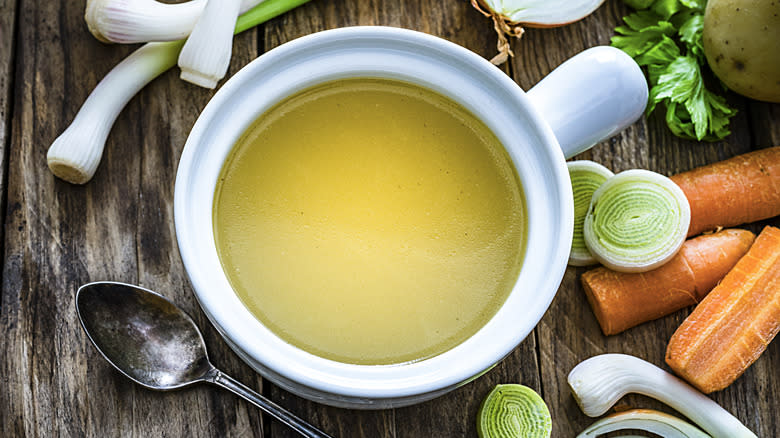
Season the water from the start or use a broth to allow your potatoes time to soak in all the flavor. You can use chicken or beef broth as a liquid swap instead of water. You probably have broth available in your kitchen, making it a super simple way to level up your boiled potatoes. Swapping water for broth allows your potatoes to soak in the savory glory as they cook. If your broth already contains sodium, you don't have to stop your water. However, if you use a low-sodium broth, make sure to add a bunch of salt to your water before it boils for maximum flavor.
You can also season the water ahead of time if you don't have broth on hand. Try a dash of paprika, cayenne, red pepper flakes, allspice, mustard powder, or freshly chopped garlic etc. Gain inspiration from seafood boils, which often use boiled potatoes, and add oregano, thyme, orange, lemons, or classic Old Bay seasoning for good measure. The more seasoning, the merrier. Don't forget to scoop some of your delicious homemade broth onto your boiled potato when serving.
Top Your Potatoes With Herbs
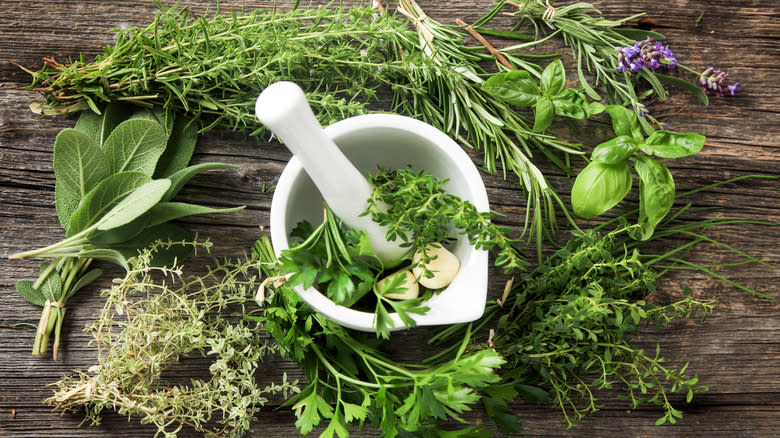
Herbs are popular in cooking thanks to their diversity. They add flavor and aromatics without much effort, and you can find them in just about any grocery store, farmers market, or produce stand. The herbs you should be adding to your boiled potatoes include oregano, thyme, dill, parsley, rosemary, sage, or tarragon. Pick herbs that complement your potatoes and the other dishes that you're serving during your meal.
Keep things simple during the boiling process. You don't have to add flavor to your potatoes from the start, it can be at the end with delicious herbs. Top your potatoes with these fresh herbs to give them a pop. Chop them up and sprinkle on your freshly boiled potato. This allows the herb to get slightly steamed and release more flavor into your potatoes. Try combinations like rosemary and sage potatoes or thyme and parsley. Replace fresh herbs and use dried if that's what you have in your spice cabinet. Dried herbs add subtle flavor without adding too much texture.
Flavor It With Something Fatty
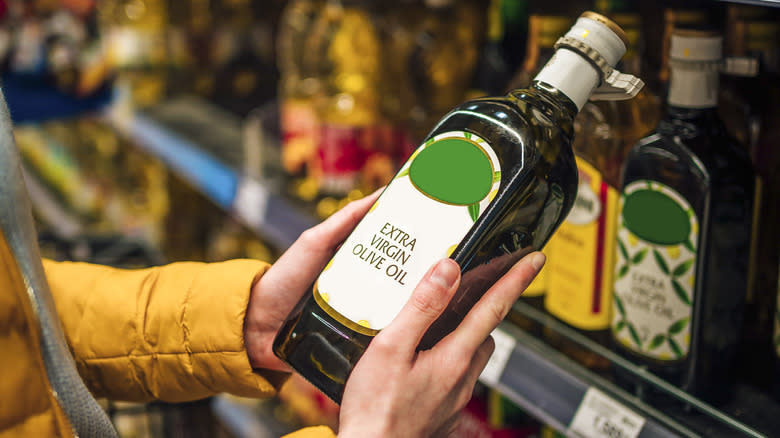
Bolster the flavor of your boiled potatoes with a fat source. Whether you choose olive oil, butter, duck fat, or beef drippings, the fat will give your boiled potatoes some depth. You won't want to add it to the water as it's boiling since it'll be diluted, so you should add fat when you're prepping your potatoes after they're cooked. Olive oil complements the taste of potatoes perfectly, especially if you pair it with garlic and lemon juice. Both potatoes and olive oil have an earthy taste, but the olive oil gives it a creaminess. Add a drizzle of olive oil so your potato isn't overly oily.
Pour in any leftover meat drippings such as bacon fat or beef drippings onto your potatoes to give them a boost. Not only is it more earth-conscious since you're eliminating food waste, but it genuinely gives it more flavor. Heat the beef drippings separately so it's warmed up and then pour it onto your boiled potatoes. Cut your potato in half to let the fat seep in. Sprinkle some salt flakes and enjoy.
Boil, Drain, Then Reheat Your Potatoes
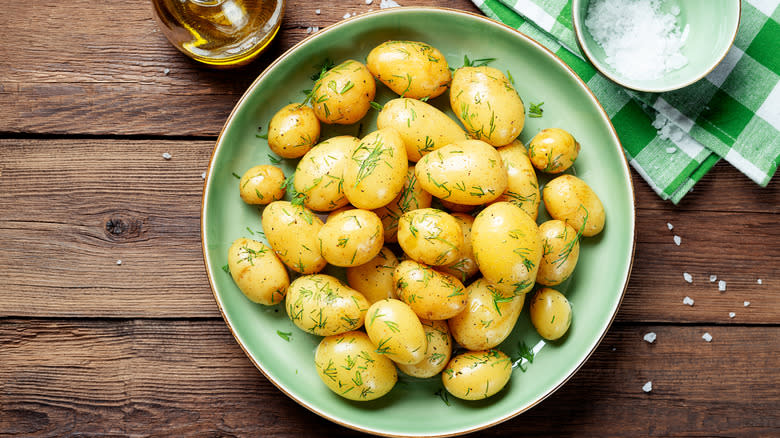
Have you tried double-cooking your potatoes? After your potatoes are fully boiled, drain them as a first measure to remove any excess liquid. Then heat them again for about two minutes to remove any moisture. This potato cooking tip from Emeril Lagasse eliminates extra moisture from your boiled potatoes, giving them a better canvas for flavor. His tip recommends boiling the potatoes with the skin on and if you feel inclined, peeling them after. Now your potatoes are ready to season. Emeril often uses truffle oil, garlic, or Parmesan in his potato-based recipe.
For a cold potato salad using small boiled potatoes, Emeril seasons the potatoes with salt, pepper, mashed garlic, mayonnaise, buttermilk, celery leaves, parsley, green onions, lemon juice, and Emeril's Creole seasoning. Try making your version of the most popular dish on Emeril's menu, Potatoes Alexa, where the potatoes are boiled, cut, and then hollowed out. His version includes half-and-half, Parmigiano-Reggiano cheese, truffle oil, and Portobello-truffle emulsion. Save time by opting for something slightly easier to create. You can also use your boiled potatoes as a starting point for other recipes like mashed potatoes or gnocchi.
Crack Open A Beer
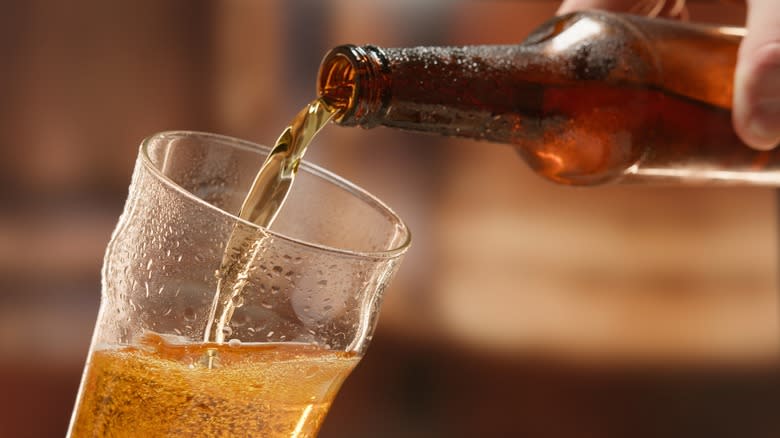
Beer is often used in cooking such as beer-battered fish or chicken, chili, or Portuguese New England clam boil, but now you can include it in your potatoes. Start by adding one or two 12-ounce bottles to your water before boiling and then cook your potatoes as usual. For a more potent taste, substitute the water entirely for beer as your boiling liquid to give it an earthy flavor. You can mix up the flavor and aroma depending on the beer that you choose to use.
A light lager will provide a milder taste than a rich dark stout. Try a porter or stout if you're pairing your boiled potatoes with meat; It'll provide a complexity to the potatoes and might even give them a tint, depending on how dark the beer is. Pour in an IPA or amber beer for a slight bitterness that goes well if you're serving your potatoes with tomatoes, lemon juice, or something tangy like sour cream.
Pour In Some Wine

Wine can elevate your potatoes to new heights. Wine is often used to cook potatoes, from Summertime Cajun crab boil to white wine instant mashed potatoes. You can get creative on what wine you want to use, but as a general tip for cooking with wine, don't cook with a wine you wouldn't want to drink. Just because you're not sipping and savoring each droplet, doesn't mean you're not tasting it during the meal. Ultimately it's going to be in the food that you're eating, so pick a wine that you find palatable.
Pour wine into the water as it boils to give the boiled potatoes a kick. Pinot Grigio makes a great choice since it's versatile and you can find affordable bottles at your local grocery store. Your white wine-infused boiled potatoes will go well with chicken or seafood dishes. At the last minute, add a package of shrimp or some crab legs to your potatoes to allow them a couple of minutes to heat thoroughly without overcooking them. Strain them or take them out of the wine and water mixture so they don't continue cooking or get too chewy. Try a robust red wine like Cabernet Sauvignon or Merlot boiled potatoes to pair with meats like steak or brisket.
Find Inspiration From Other Cultures
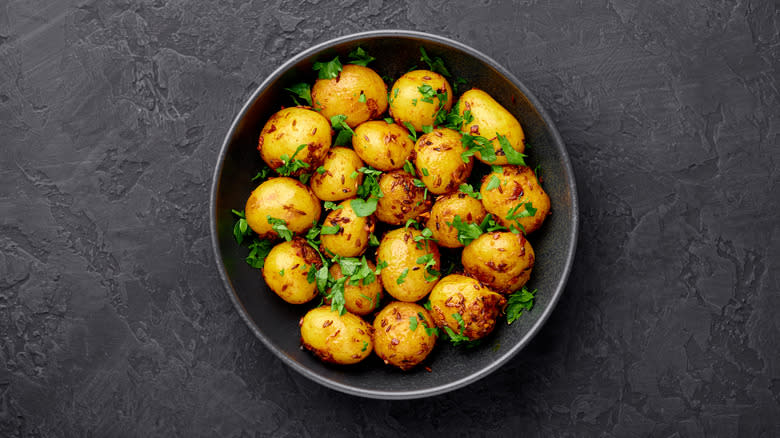
Follow cultural recipes to completely mix up the flavor of your boiled potatoes. You don't have to boil your potatoes plain and call it a day taste-wise. Get a bite of inspiration from the world. Make jeera aloo, an Indian dish of cumin potatoes, if you want potatoes stacked with flavor. While recipes will differ, jeera aloo usually contains potatoes, loads of freshly toasted cumin seeds, and other ingredients like lemon, ginger, and coriander.
Perhaps you want to make Spanish patatas hervidas with Spanish paprika and saffron or tacos de papa, a Mexican dish made with boiled potato and corn tortillas. No need to purchase a plane ticket when there are so many boiled potato recipes from all over the globe at your fingertips. You can pick what to make based on ease, ingredients you already have at home, or if you want something unique and challenging. It doesn't matter which you choose, since each recipe will make your mouth water.
Read the original article on Tasting Table.

